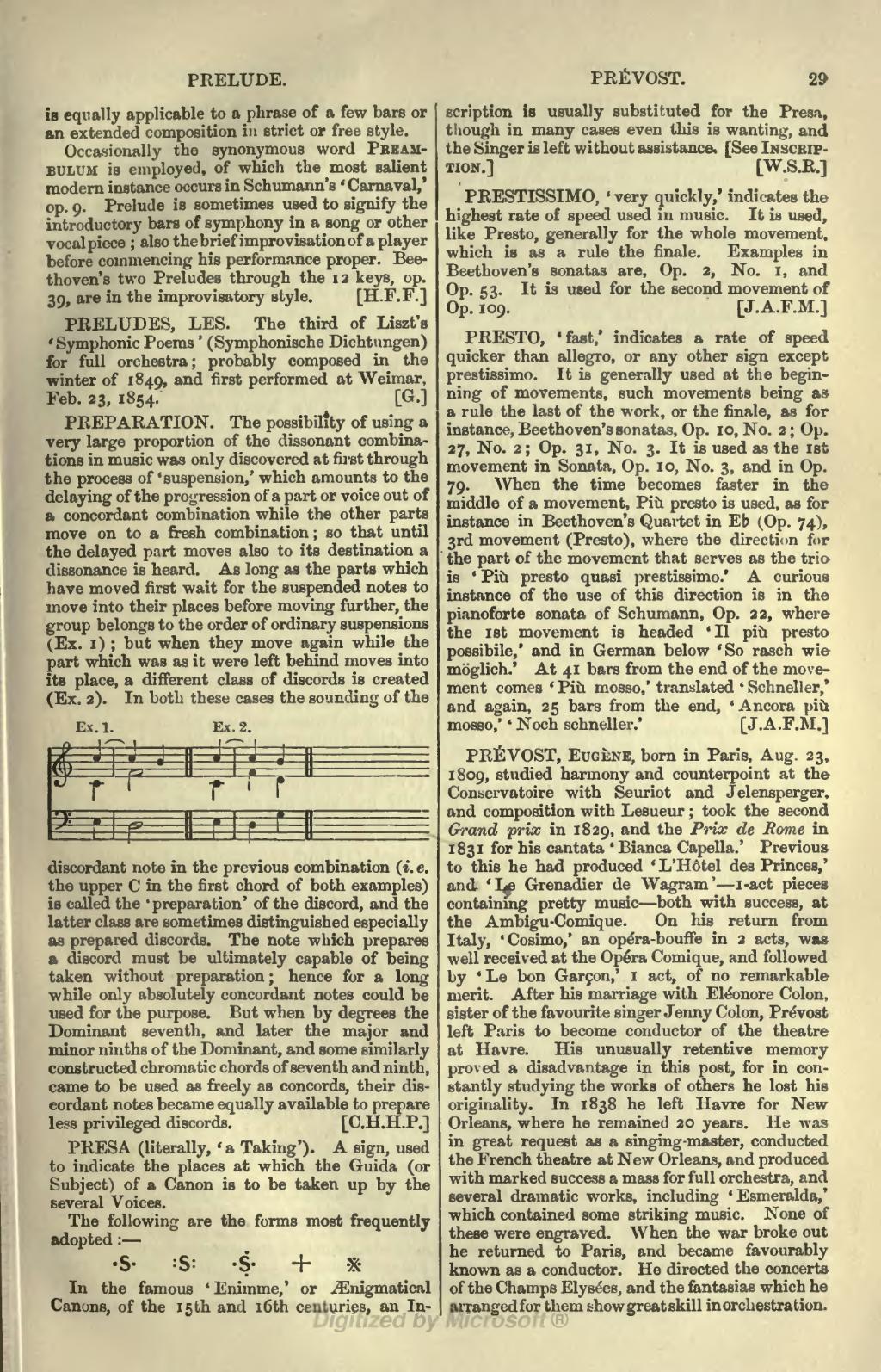is equally applicable to a phrase of a few bars or an extended composition in strict or free style.
Occasionally the synonymous word Preambulum is employed, of which the most salient modern instance occurs in Schumann's 'Carnaval,' op. 9. Prelude is sometimes used to signify the introductory bars of symphony in a song or other vocal piece; also the brief improvisation of a player before commencing his performance proper. Beethoven's two Preludes through the 12 keys, op. 39, are in the improvisatory style.
PRELUDES, LES. The third of Liszt's 'Symphonic Poems' (Symphonische Dichtungen) for full orchestra; probably composed in the winter of 1849, and first performed at Weimar, Feb. 23, 1854.
PREPARATION. The possibility of using a very large proportion of the dissonant combinations in music was only discovered at first through the process of 'suspension,' which amounts to the delaying of the progression of a part or voice out of a concordant combination while the other parts move on to a fresh combination; so that until the delayed part moves also to its destination a dissonance is heard. As long as the parts which have moved first wait for the suspended notes to move into their places before moving further, the group belongs to the order of ordinary suspensions (Ex. 1); but when they move again while the part which was as it were left behind moves into its place, a different class of discords is created (Ex. 2).

In both these cases the sounding of the discordant note in the previous combination (i.e. the upper C in the first chord of both examples) is called the 'preparation' of the discord, and the latter class are sometimes distinguished especially as prepared discords. The note which prepares a discord must be ultimately capable of being taken without preparation; hence for a long while only absolutely concordant notes could be used for the purpose. But when by degrees the Dominant seventh, and later the major and minor ninths of the Dominant, and some similarly constructed chromatic chords of seventh and ninth, came to be used as freely as concords, their discordant notes became equally available to prepare less privileged discords.
PRESA (literally, 'a Taking'). A sign, used to indicate the places at which the Guida (or Subject) of a Canon is to be taken up by the several Voices.
The following are the forms most frequently adopted:—
·S·∶S∶·Ṩ·🞢※
In the famous 'Enimme,' or Enigmatical Canons, of the 15th and 16th centuries, an Inscription is usually substituted for the Presa, though in many cases even this is wanting, and the Singer is left without assistance, [See Inscription.]
PRESTISSIMO, 'very quickly,' indicates the highest rate of speed used in music. It is used, like Presto, generally for the whole movement, which is as a rule the finale. Examples in Beethoven's sonatas are, Op. 2, No. 1, and Op. 53. It is used for the second movement of Op. 109.
PRESTO, 'fast,' indicates a rate of speed quicker than allegro, or any other sign except prestissimo. It is generally used at the beginning of movements, such movements being as a rule the last of the work, or the finale, as for instance, Beethoven's sonatas, Op. 10, No. 2; Op. 27, No. 2; Op. 31, No. 3. It is used as the 1st movement in Sonata, Op. 10, No. 3, and in Op. 79. When the time becomes faster in the middle of a movement, Più presto is used, as for instance in Beethoven's Quartet in E♭ (Op. 74), 3rd movement (Presto), where the direction for the part of the movement that serves as the trio is 'Più presto quasi prestissimo.' A curious instance of the use of this direction is in the pianoforte sonata of Schumann, Op. 22, where the 1st movement is headed 'Il piú presto possibile,' and in German below 'So rasch wie moglich.' At 41 bars from the end of the movement comes 'Più mosso,' translated 'Schneller,' and again, 25 bars from the end, 'Ancora più mosso,' 'Noch schneller.'
PRÉVOST, Eugène, born in Paris, Aug. 23, 1809, studied harmony and counterpoint at the Conservatoire with Seuriot and Jelensperger, and composition with Lesueur; took the second Grand prix in 1829, and the Prix de Rome in 1831 for his cantata 'Bianca Capella.' Previous to this he had produced 'L'Hôtel des Princes,' and 'Le Grenadier de Wagram'—1-act pieces containing pretty music—both with success, at the Ambigu-Comique. On his return from Italy, 'Cosimo,' an opéra-bouffe in 2 acts, was well received at the Opéra Comique, and followed by 'Le bon Garçon,' 1 act, of no remarkable merit. After his marriage with Eléonore Colon, sister of the favourite singer Jenny Colon, Prévost left Paris to become conductor of the theatre at Havre. His unusually retentive memory proved a disadvantage in this post, for in constantly studying the works of others he lost his originality. In 1838 he left Havre for New Orleans, where he remained 20 years. He was in great request as a singing-master, conducted the French theatre at New Orleans, and produced with marked success a mass for full orchestra, and several dramatic works, including 'Esmeralda,' which contained some striking music. None of these were engraved. When the war broke out he returned to Paris, and became favourably known as a conductor. He directed the concerts of the Champs Elysées, and the fantasias which he arranged for them show great skill in orchestration.
